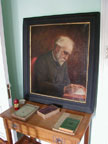
|
|
|
|
|
|
|
|
|
|
Abram S. Hewitt

Abram Stevens Hewitt, iron manufacturer, congressman, and mayor of New York City, was born near Haverstraw, New York, the son of a cabinetmaker. After attending public schools, he entered the Grammar School at Columbia College at the age of thirteen. Three years later he won a scholarship to Columbia College, where he ranked first in his class in academics.
Upon graduation from Columbia in 1842, he began the study of law while also teaching mathematics at Columbia�s grammar school. At this time he tutored Edward Cooper, the son of inventor and manufacturer Peter Cooper. In 1843-1844 Hewitt traveled to Europe with Edward Cooper, and the two were shipwrecked on their return voyage. This harrowing adventure strengthened their friendship, and henceforth Hewitt was regarded as virtually a member of the Cooper family. In 1845, with Peter Cooper�s backing, the two friends established the Trenton Iron Works. They proved highly successful, manufacturing not only rails and wire but also iron beams used widely in building construction. In 1855 Hewitt cemented his relationship with the Cooper family when he married Sarah Amelia Cooper, Peter Cooper�s only daughter. The couple had six children.
Though a Democrat and consequently not totally in accord with President Abraham Lincoln�s policies, Hewitt contributed to the Union cause during the Civil War by manufacturing gun barrel iron for the government at virtually production cost. After the war, President Andrew Johnson appointed Hewitt as one of the American commissioners to the Paris Exhibition of 1867, and while in Europe Hewitt surveyed the latest techniques in iron and steel manufacturing. He recorded his findings in a highly acclaimed report to the U.S. government. As a result of his investigations, Hewitt introduced the open-hearth process for manufacturing steel into the United States in 1867-1869.
By the early 1870s Hewitt�s interests were turning from manufacturing to politics. Together with Edward Cooper he helped topple the corrupt Tweed Ring, which had ruled New York City, and he endeavored to reform Tammany Hall, the New York City Democratic organization. In 1874 he was elected to the U.S. House of Representatives from New York City and served in that branch of Congress for ten of the next twelve years. As a congressman he favored moderate tariff reform, especially seeking lower tariffs on raw materials. He also sponsored the legislation that established the U.S. Geological Survey. Though Hewitt was frustrated by his inability to achieve more in Congress, most notably to reduce tariffs, others viewed him as one of the nation�s leading legislators. In his autobiography, The Education of Henry Adams (1907), Henry B. Adams pronounced Hewitt �the most useful public man in Washington,� and he claimed to know of �no other man who had done so much.�
In 1876 Hewitt was chairman of the Democratic National Committee and managed New York Governor Samuel Tilden�s unsuccessful race for the presidency. Two years later, disgruntled Tammany boss John Kelly (1822-1886) deprived Hewitt of renomination to Congress, and in 1880-1881 Hewitt and Cooper retaliated by joining with others in founding a rival party faction known as the County Democracy. Despite continued factional feuding, Hewitt was reelected to Congress in 1880, 1882, and 1884.
In 1886 Hewitt�s career took a new turn when he accepted the Democratic nomination for mayor of New York City. The radical reformer Henry George (1839-1897) was running on the United Labor party ticket, and to thwart George, Tammany and the County Democracy joined in support of Hewitt. On election day Hewitt handily defeated George as well as the Republican Party candidate Theodore Roosevelt (1858-1919).
As mayor Hewitt sought to ensure honest administration and eliminate corruption. In the process he became embroiled in patronage battles with Tammany, refusing to appoint some Tammany men to office. He also endeavored to enforce the law that prohibited saloons from operating on Sundays. This earned him the enmity of many saloon keepers and imbibers. He further outraged many New Yorkers when he refused to take a place in the reviewing stand at the St. Patrick�s Day Parade of 1888. Critical of the divided national loyalties of many immigrants, Hewitt would not participate in this Irish celebration. In the heavily Irish city, this decision proved unpopular and contributed to Hewitt�s defeat for reelection in 1888.
Mayor Hewitt also urged some more farsighted initiatives. He supported the creation of small parks in the city�s congested neighborhoods, and he introduced a plan for building an underground mass transit system. His scheme for the financing and construction of a subway system was not implemented until a decade after he stepped down as mayor.
Following his defeat for reelection by Hugh Grant, the Tammany candidate, Hewitt devoted an increasing amount of his time to philanthropy. In the 1850s Peter Cooper had founded Cooper Union, an educational institution for the working classes. During the decade before his death in New York City, Hewitt endeavored to put Cooper Union on a sound financial footing, donating much of his own money to the Union endowment.
As a manufacturer and a public official, Hewitt epitomized Victorian America and its values. Throughout his business career, he demonstrated a boundless, positive faith in economic growth and technological progress. He was also a model of moral rectitude whose rigid devotion to principle damaged his political fortunes. Honest to the point of bluntness, he was a pillar of righteousness in a political world demanding compromise and pragmatism.
The Dictionary of American National Biography, Oxford University Press, 2000.